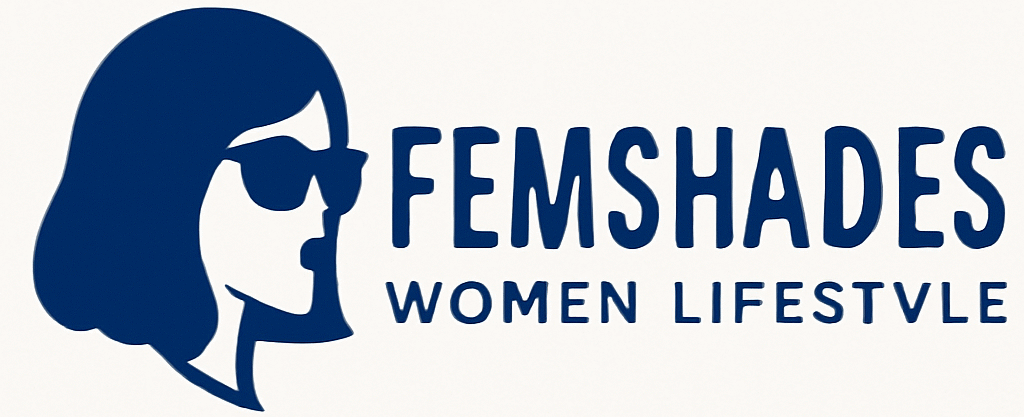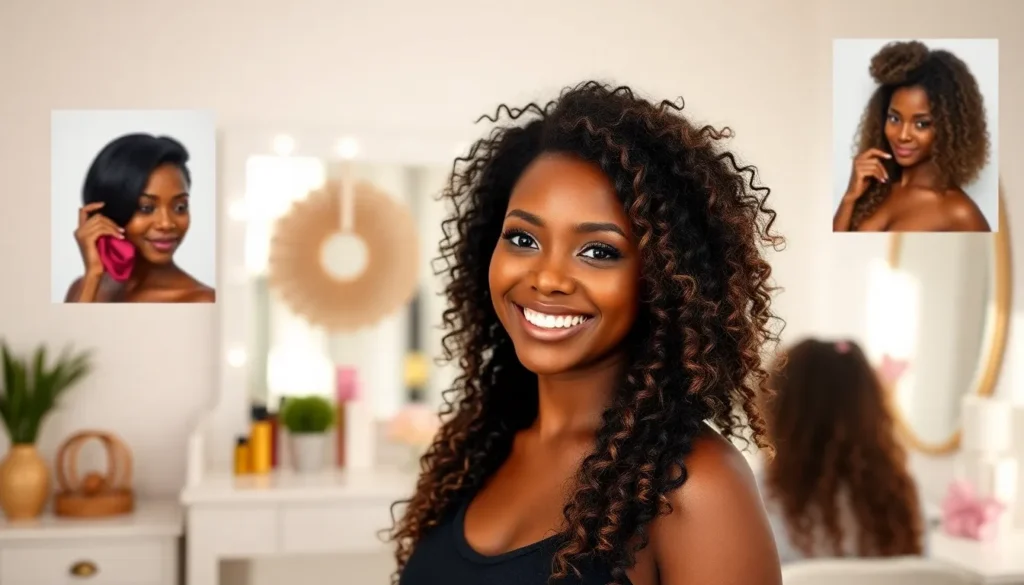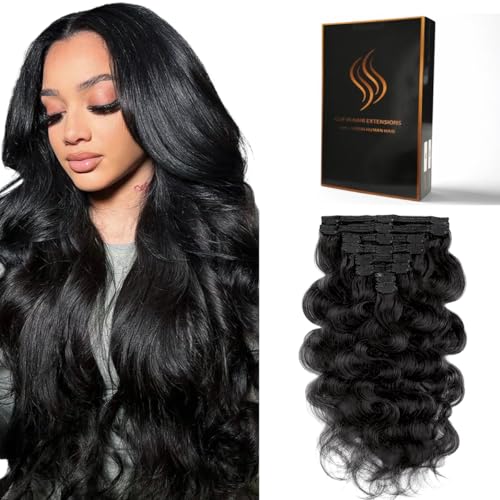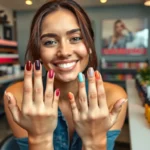We’ve all dreamed of having longer, fuller hair that transforms our look in minutes. For Black women seeking versatile styling options without the commitment of permanent extensions, clip-ins offer the perfect solution. These temporary hair additions let us experiment with different lengths, volumes, and textures while protecting our natural hair.
Clip-in extensions have revolutionized how we approach hair styling, giving us the freedom to switch from a sleek bob to flowing curls whenever we want. Unlike traditional sew-ins or glue-in methods, clip-ins won’t damage our natural hair or require hours at the salon.
Whether you’re preparing for a special event, want to add volume to fine hair, or simply love changing your look regularly, clip-in extensions designed specifically for Black hair textures can be game-changers. We’ll explore everything you need to know about choosing, applying, and maintaining these versatile hair accessories.
Understanding Clip In Hair Extensions for Black Women
Let’s explore the fundamentals of clip in hair extensions and why they’ve become a game changer for Black women seeking versatile styling options.
What Are Clip In Hair Extensions
Clip in hair extensions are temporary hair pieces that attach to your natural hair using small clips or pressure-sensitive clamps. These extensions come in various textures including kinky, coily, curly, and relaxed styles that match natural Black hair patterns. We typically find them available in wefts ranging from 1 to 8 inches wide, with the most popular sizes being 4-inch and 6-inch pieces.
The clips themselves are usually made from stainless steel or reinforced plastic, designed to grip securely without causing breakage. Most sets include 6 to 12 individual wefts in different sizes to create natural layering and fullness. Quality clip ins use 100% human hair or high-grade synthetic fibers that can withstand heat styling up to 350°F.
Why They’re Perfect for Natural Hair
Natural Black hair textures work exceptionally well with clip in extensions because they provide excellent grip and camouflage. The coily and kinky patterns create natural hiding spots for clips, making them virtually undetectable when properly installed. We’ve found that 4C hair textures particularly excel at concealing the attachment points.
These extensions protect your natural hair from daily manipulation that can lead to breakage. You can achieve length and volume goals while allowing your own hair to rest and grow underneath. The temporary nature means you’re not committed to one look, which aligns perfectly with the versatility that many Black women desire in their hair routine.
Clip ins also work wonderfully with protective styles like twist outs, braid outs, and wash and go styles. They blend seamlessly when the textures are matched correctly to your natural hair pattern.
Benefits Over Permanent Extensions
Cost effectiveness ranks as the primary advantage, with quality clip in sets ranging from $50 to $300 compared to $500 to $2000 for permanent installations. You can reuse clip ins for 6 to 12 months with proper care, making them significantly more economical over time.
Time savings represent another major benefit since application takes only 10 to 20 minutes versus 3 to 8 hours for sewn in weaves or individual braids. We can install them at home without professional assistance, eliminating salon appointments and scheduling constraints.
Hair health improves dramatically because clip ins don’t require glue, heat, or tight braiding that can cause tension alopecia or follicle damage. Your scalp can breathe freely, and you maintain full access for washing and conditioning your natural hair. The ability to remove them nightly prevents matting and tangling that often occurs with permanent extensions.
Styling flexibility allows you to switch between your natural texture and extended styles daily. You can wear your natural hair to the gym and add length for evening events without any long term commitment or damage to your hair’s integrity.
Choosing the Right Texture for Your Hair Type
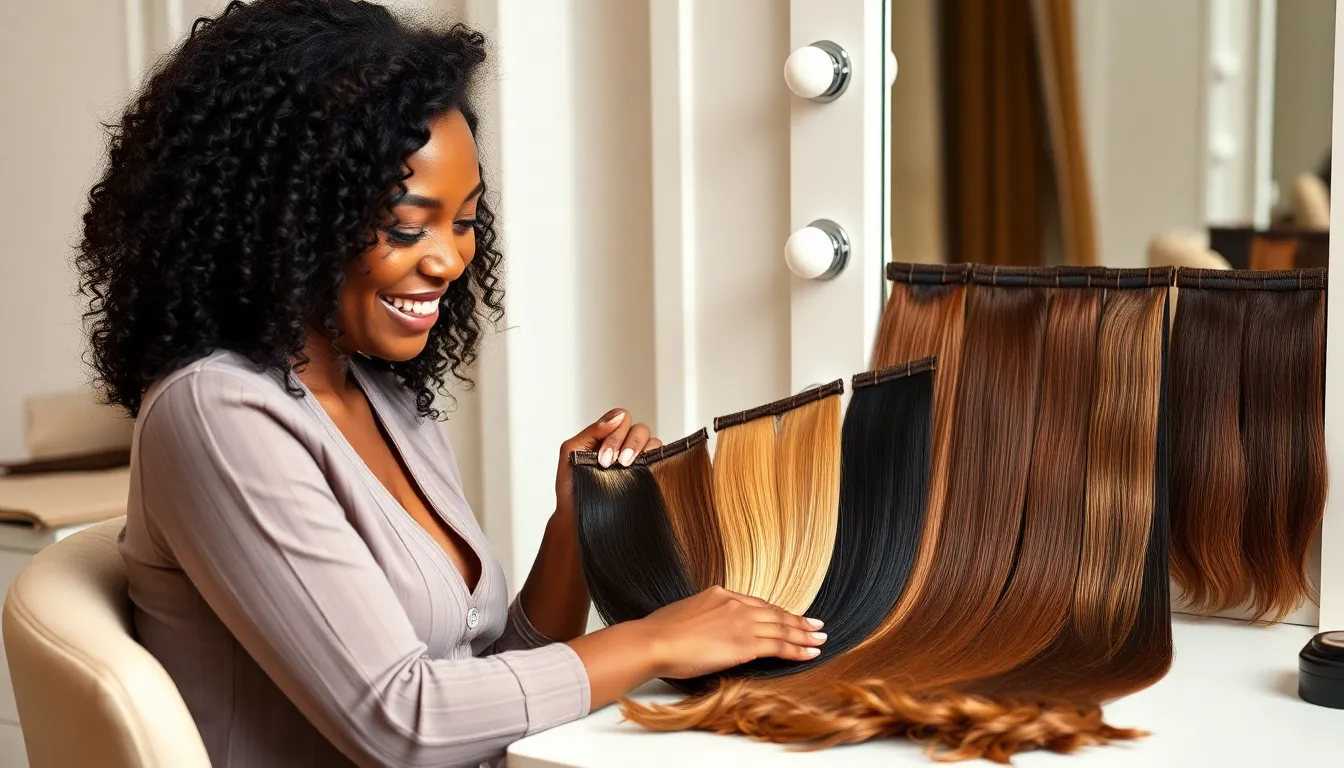
Selecting clip in extensions that perfectly match your natural hair texture creates a seamless, undetectable blend. We’ll guide you through matching different textures to ensure your extensions look natural and complement your unique hair pattern.
Matching Your Natural Hair Texture
Understanding your curl pattern is the foundation for choosing extensions that blend flawlessly with your natural hair. We recommend identifying whether you have type 3 (curly) or type 4 (coily/kinky) hair patterns before shopping for clip ins. Brands now offer extensions specifically designed for black hair, replicating natural textures across the entire curl spectrum.
Color matching works hand in hand with texture selection to prevent visible demarcation lines. We suggest taking photos of your hair in natural lighting to compare with extension swatches. Density considerations matter just as much as curl pattern since mismatched thickness creates an obvious contrast between your natural hair and the extensions.
Kinky and Coily Extension Options
Type 4 hair textures benefit from kinky and coily extensions that replicate tight curls and natural volume. We find that these extensions excel at blending with dense, springy hair patterns that characterize most black hair types. Human hair options provide the most realistic movement and styling versatility for kinky textures.
High quality synthetic fibers offer budget friendly alternatives that still maintain authenticity in appearance and feel. We notice that kinky extensions often feature extra bounce and density to match the natural characteristics of afro textured hair. Brands create these extensions to withstand styling while maintaining their coil definition throughout wear.
Curly and Wavy Extension Varieties
Type 3 hair patterns pair beautifully with curly and wavy clip in extensions that maintain natural curl definition. We recommend choosing extensions that match your exact curl size, whether loose waves or tight spirals. Volume and movement characteristics should align with your natural hair’s behavior for the most convincing results.
Length selection becomes crucial with curly extensions since curls shrink significantly when dry compared to straight hair. We suggest purchasing extensions slightly longer than your target length to account for curl contraction. Proper curl size matching prevents the extensions from appearing too uniform or artificial against your natural texture variation.
Selecting the Perfect Color Match

We know that achieving the perfect color match is essential for creating a natural look with your clip-in extensions. The right shade ensures seamless blending with your natural hair texture and creates an undetectable finish.
Finding Your Exact Shade
Understand your base hair color by examining your roots in natural sunlight, as this provides the most accurate representation of your true shade. Natural lighting reveals undertones that artificial lighting often masks or distorts.
Use color charts from reputable extension brands to compare your hair against standardized color swatches. Most professional brands provide detailed color matching guides that account for the unique color variations in Black hair.
Request color samples before making your final purchase to test the match against your natural hair. We recommend ordering 2-3 similar shades since monitor displays can vary significantly from actual colors.
Consult a professional stylist who specializes in extensions for Black hair if you’re unsure about your color match. Experienced stylists can identify subtle undertones and recommend the best shade combinations for your exact hair color.
Ombre and Highlight Options
Gradual color transitions in ombre extensions create stunning dimensional effects that complement natural Black hair beautifully. These extensions feature darker roots that gradually lighten toward the ends, mimicking natural sun-kissed highlights.
Dimensional highlights add depth and movement to your hairstyle without the commitment of permanent coloring. Highlighted clip-ins can be strategically placed to frame your face or create subtle accents throughout your hair.
Popular ombre combinations for Black hair include natural black to chocolate brown, dark brown to caramel, and black to burgundy for bold statement looks. These color progressions work particularly well with curly and coily textures.
Strategic placement of ombre and highlighted pieces requires careful consideration of your natural hair’s curl pattern. Coily hair naturally creates shadow and depth, making it easier to blend transitional colors seamlessly.
Custom Color Blending Tips
Mix and match different shades to create a multi-dimensional look that perfectly complements your natural hair color. We recommend using 2-3 complementary shades rather than relying on a single color.
Layer colors strategically by placing darker shades underneath and lighter tones on top to create natural-looking depth. This technique mimics how natural hair catches and reflects light.
Work with a professional colorist for complex color blends that require multiple shades or dramatic color changes. Professional stylists can create custom color combinations that enhance your skin tone and natural hair color.
Test your blend by clipping in all chosen shades together before your final styling session. This allows you to adjust the color ratio and placement for the most natural-looking result.
Consider your skin undertones when selecting multiple colors, as warm and cool tones can clash if not properly balanced. Golden and honey tones typically complement warm undertones, while ash and cool browns work better with cool undertones.
Determining the Right Length and Volume

Getting the perfect length and volume for your clip-in extensions requires careful planning to achieve a natural, seamless look. We’ll guide you through the essential measurements and calculations to ensure your extensions blend flawlessly with your natural hair.
Measuring for Ideal Length
Measuring from the crown of your head to where you want the extensions to reach gives you the foundation for selecting the right length. We recommend considering your height and body proportions to ensure the extensions complement your overall appearance rather than overwhelming your frame.
Natural light provides the most accurate assessment when determining your desired length. Take photos from different angles to visualize how various lengths will look with your face shape and body type. Remember that curly and coily textures will appear shorter than straight measurements due to shrinkage patterns.
Your lifestyle also influences the ideal length choice. Consider how often you’ll style your hair up versus down, as longer extensions may limit certain protective styling options. We suggest measuring at multiple points around your head since hair naturally varies in length from front to back.
Calculating Wefts Needed
The number of wefts required depends on how much volume you want to add to your natural hair. For average volume enhancement, 2-3 wefts provide sufficient fullness without creating an obviously artificial appearance.
Thicker natural hair or desires for fuller volume require additional wefts to achieve the desired effect. We recommend starting with fewer wefts and gradually adding more if needed, as it’s easier to build volume incrementally than to remove excess bulk.
Your hair density at the crown and sides determines the strategic placement of wefts. Fine or sparse areas may need fewer wefts to avoid visible attachment points, while denser sections can accommodate more pieces without detection.
Layering for Natural Volume
Layering your extensions starting from the bottom and working upward creates the most natural volume distribution. Begin with a weft at the nape of your neck, then apply additional wefts above it, ensuring each layer sits slightly higher than the previous one.
Each weft should blend seamlessly with your natural hairline to avoid obvious demarcation lines. We suggest using a lighter application technique around the crown area to prevent visible attachment points that can compromise the natural appearance.
Strategic spacing between layers allows your natural hair to intermingle with the extensions effectively. Consider leaving small sections of natural hair between wefts to create a more organic blend that moves naturally with your hair’s texture patterns.
Preparing Your Natural Hair for Application
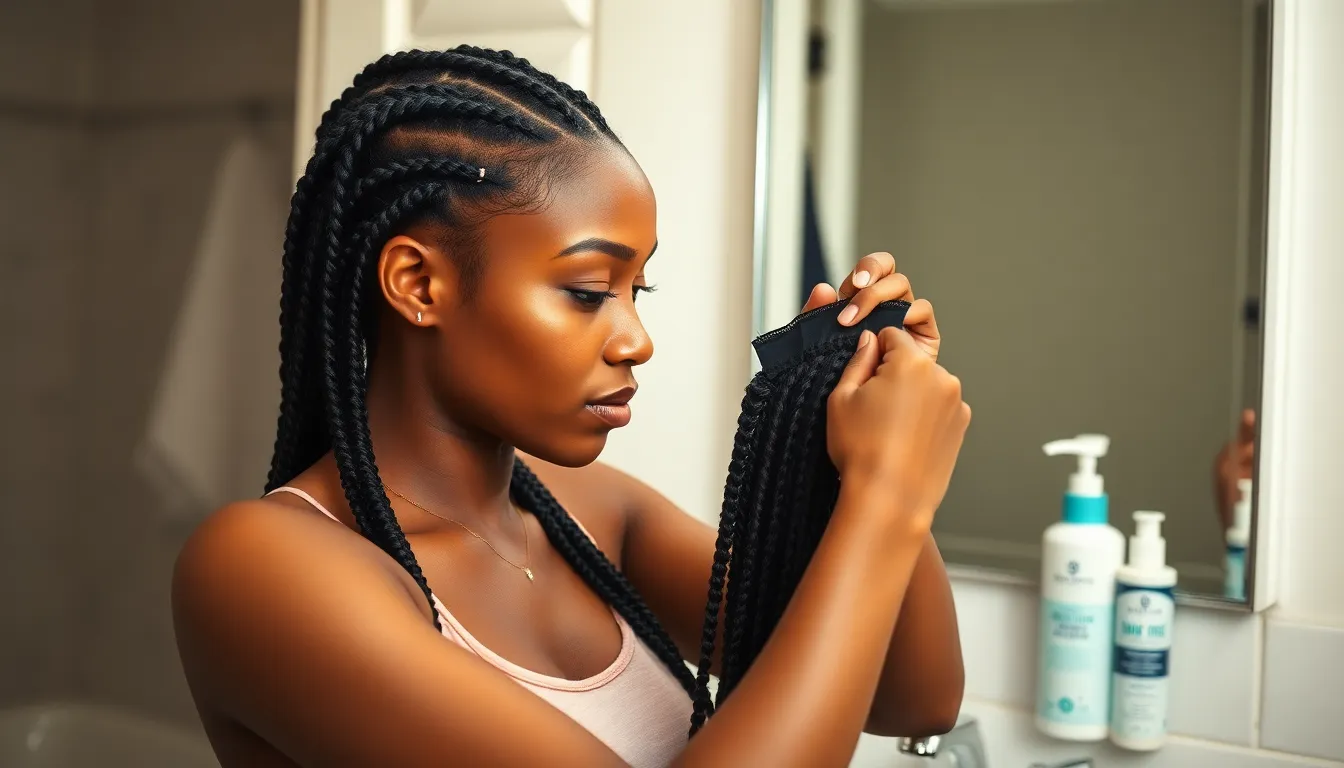
We’ll walk you through the essential steps to properly prepare your natural hair before applying clip-in extensions. Proper preparation ensures better hold, prevents damage, and creates a flawless blend with your natural texture.
Washing and Conditioning Guidelines
Start with a sulfate-free shampoo to maintain your hair’s natural oils and prevent excessive dryness. Sulfate-free formulas are gentler on textured hair and won’t strip away the moisture that Black hair naturally needs.
Apply a deep conditioning treatment to restore hydration and create a smooth foundation for your extensions. Focus the conditioner from mid-length to ends, avoiding the roots to prevent weighing down your hair.
Rinse thoroughly with cool water to seal the hair cuticles and lock in moisture. Cool water also helps reduce frizz and creates a smoother surface for extension application.
Use leave-in conditioners or hair oils after washing to maintain hydration throughout the styling process. Light oils like argan or jojoba work best without creating buildup that could interfere with clip attachment.
Protective Styling Techniques
Braid your natural hair underneath where you’ll place the extensions to reduce tension on individual strands. Small, loose braids distribute weight evenly and prevent breakage at the roots.
Create flat twists along your hairline to protect these delicate areas from clip pressure. Flat twists also help create a smooth surface that allows extensions to lay flat against your head.
Section your hair strategically using horizontal parts to separate areas where clips will attach. Clean sectioning prevents tangling and ensures each weft has adequate space for secure placement.
Avoid using harsh chemicals or excessive heat styling before application. Your hair should be in its healthiest state to handle the additional weight and manipulation from extensions.
Creating the Perfect Base
Section your hair horizontally starting from ear to ear to create the foundation layer for your first weft. This bottom section should be about one inch wide and positioned where your natural hair is thickest.
Tease the sectioned hair lightly at the roots to create grip for the clips without causing damage. Use a fine-tooth comb and gentle upward strokes to build texture where clips will attach.
Place clips close to the roots but not directly against your scalp to ensure comfort and security. The clips should sit about half an inch from your scalp on the teased section of hair.
Blend the weft edges with your natural hair using a wide-tooth comb to create seamless transitions. Work from the attachment point outward, gently combining textures for a natural appearance.
Mastering the Application Process
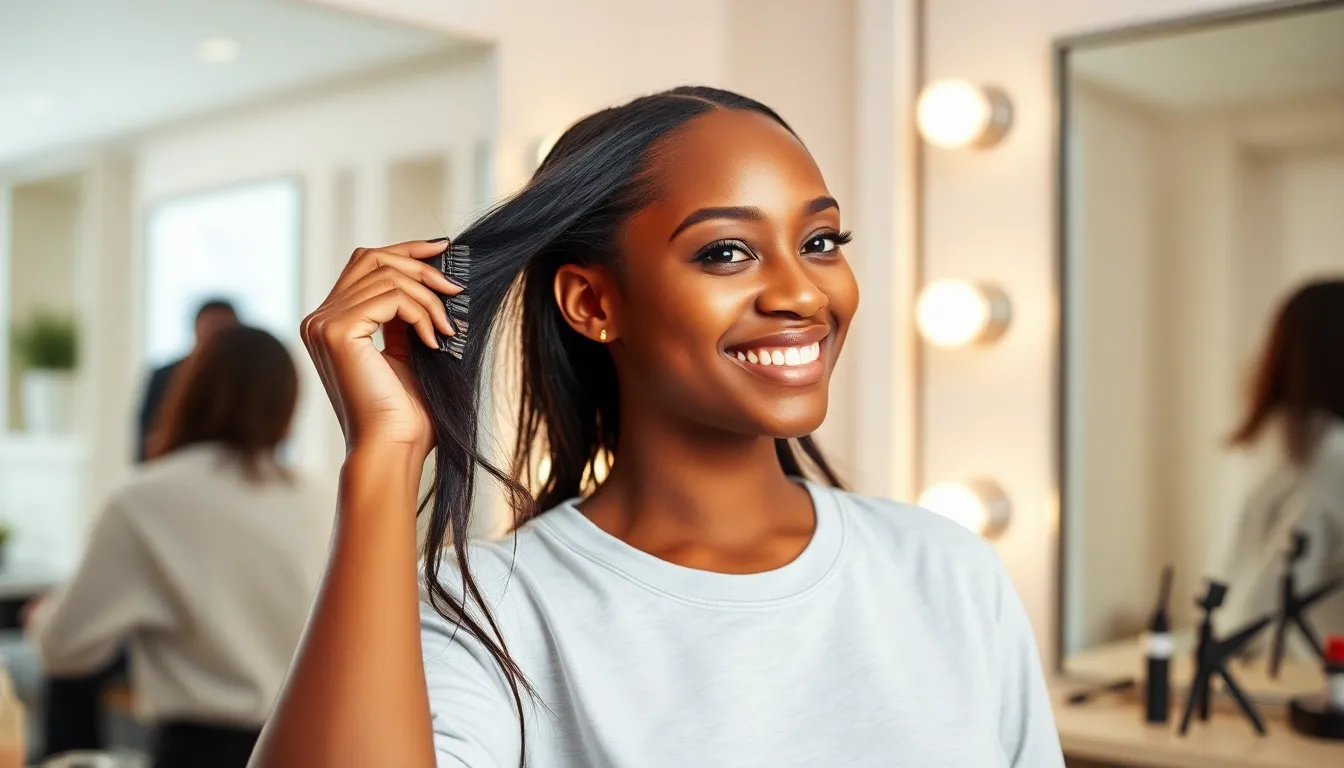
The key to achieving professional-looking results with clip-in extensions lies in mastering the proper application techniques that work specifically for Black hair textures.
Sectioning Your Hair Properly
Dividing your hair into strategic layers creates the foundation for seamless extension placement. Start by parting your hair horizontally from ear to ear, securing the top portion with clips or hair ties. Create sections that are 1-2 inches thick to ensure each weft sits flat against your scalp without creating bulk.
Working from bottom to top allows you to build natural-looking volume gradually. Begin at the nape of your neck and work upward, releasing one section at a time as you apply each weft. Use a rat-tail comb to create clean, straight parts that will help your extensions blend invisibly with your natural hair.
Maintaining consistent section thickness prevents uneven distribution and visible attachment points. Each horizontal section should be roughly the same width as your clip-in weft to ensure proper coverage. Smaller sections work better for thinner hair, while thicker sections accommodate fuller natural hair textures.
Clipping Techniques for Secure Hold
Positioning wefts horizontally just below your natural hairline creates the most secure foundation. Place the first weft at the nape of your neck, ensuring it sits about an inch above the hairline to prevent visibility. Open all clips on the weft before positioning to avoid fumbling during application.
Attaching clips as close to the roots as possible maximizes hold without causing discomfort. Press each clip firmly against your scalp, starting from the center and working outward to the edges. The clips should feel secure but not tight enough to cause tension or headaches.
Layering extensions underneath your natural hair prevents detection and ensures longevity. Apply each subsequent weft approximately 2-3 inches above the previous one, allowing your natural hair to fall over the attachment points. Release each section of natural hair immediately after clipping to check for proper coverage.
Testing the security of each weft before moving to the next prevents slipping during wear. Gently tug on each attached weft to ensure it won’t slide or fall out during normal activities. Reposition any loose clips immediately to maintain a secure hold throughout the day.
Blending Extensions Seamlessly
Using a wide-tooth comb helps distribute hair evenly without causing breakage or tangling. Gently comb through your natural hair and extensions together, starting from the ends and working upward. This technique prevents pulling on the clips while creating a smooth, blended appearance.
Matching hair textures between your natural hair and extensions eliminates obvious transitions. Choose yaki textures for straight hair or kinky textures for coily hair to ensure the most natural blend. The extensions should move and behave similarly to your natural hair for convincing results.
Creating subtle layers with your natural hair helps camouflage weft lines and attachment points. Use your fingers to gently separate and arrange hair strands over the clips, ensuring no horizontal lines are visible. Focus extra attention on the areas around your face and part lines where detection is most likely.
Styling your hair and extensions together as one unit completes the seamless integration process. Apply the same products and techniques to both your natural hair and extensions to maintain consistent texture and movement. This unified approach ensures your extensions look like a natural part of your hairstyle rather than an obvious addition.
Styling Your Clip In Extensions
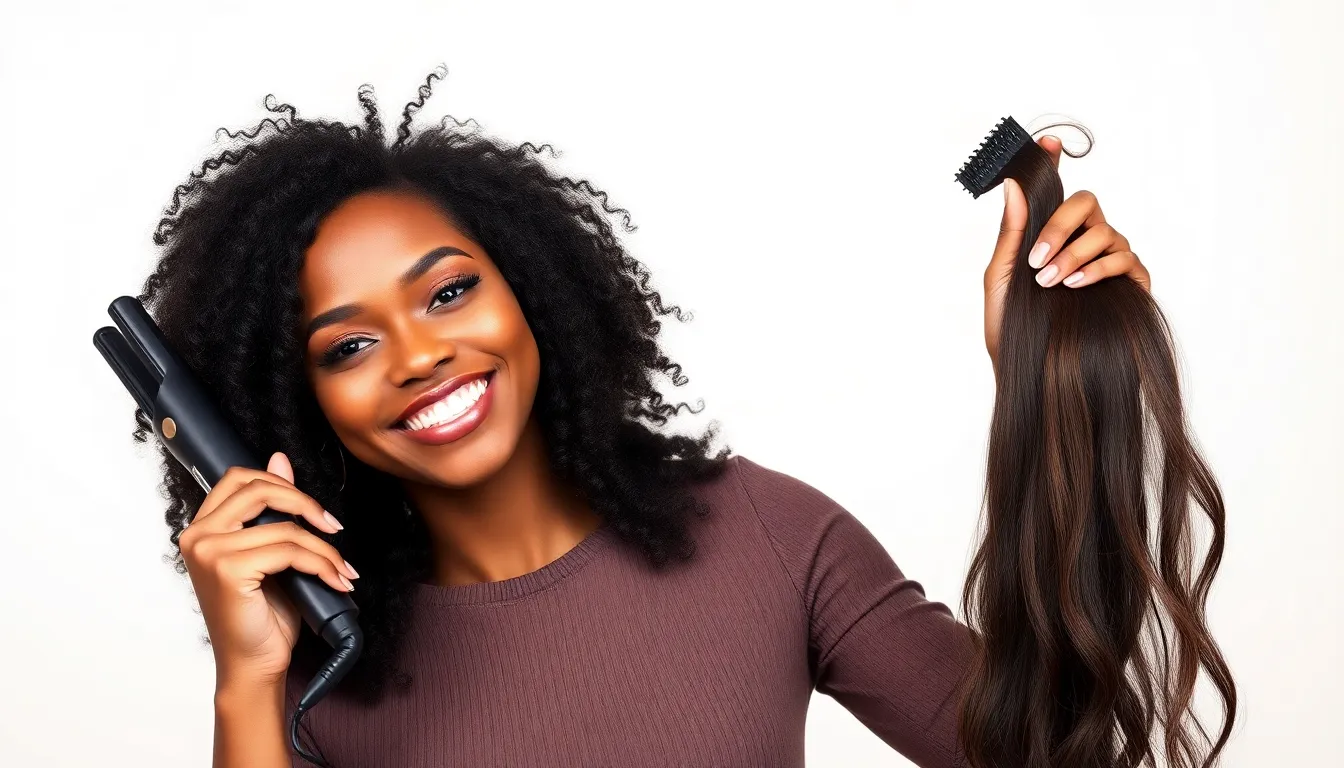
We’ll explore effective methods to style your clip in extensions while maintaining their quality and protecting your natural hair. Proper styling techniques ensure longevity and natural appearance for your extensions.
Heat Styling Safety Tips
Heat protection forms the foundation of safe styling for clip in extensions. Apply a heat protectant cream or spray before using any heating tools to minimize damage and preserve the extension’s integrity. Temperature control remains crucial—set your flat iron to no higher than 175°F for optimal results without compromising the hair fibers.
Limiting heat exposure protects both extensions and natural hair from unnecessary damage. Restrict flat iron passes to one or two per section to prevent breakage and maintain the extension’s texture. Weekly heat styling sessions work best for preserving the quality of your clip in extensions while achieving your desired look.
Professional styling tools make a important difference in results and hair health. Invest in ceramic or titanium flat irons that distribute heat evenly and reduce hot spots. Quality tools prevent damage while creating smoother, longer lasting styles that blend seamlessly with your natural hair texture.
Protective Styling Options
Clip in extensions provide excellent protective styling opportunities for Black women seeking to minimize daily hair manipulation. Remove extensions easily at night to allow your scalp and natural hair to rest from tension. This approach reduces the risk of traction alopecia compared to permanent weaves or braids when clipped securely but not too tightly.
Low manipulation styles work exceptionally well with clip in extensions for extended wear. Create loose buns, gentle braids, or twist outs that don’t stress the clip attachment points. These styles promote hair growth by minimizing stress on your roots while maintaining an elegant appearance throughout the day.
Strategic placement allows your natural hair to benefit from reduced styling stress. Focus heat and manipulation on the extensions rather than your natural hair whenever possible. This method preserves your hair’s health while achieving versatile looks that would otherwise require extensive styling of your natural strands.
Maintaining Curl Patterns
Water based moisturizers preserve the natural curl pattern of both your hair and extensions. Apply lightweight leave in conditioners to maintain softness and prevent frizz without weighing down the curls. These products help kinky, curly, and coily textures maintain their natural movement and bounce.
Gentle detangling techniques protect curl patterns from disruption and breakage. Use wide tooth combs or your fingers to work through tangles, starting from the ends and working upward. This approach maintains the integrity of both natural and extension curl patterns while preventing unnecessary stress on the hair shaft.
Regular maintenance keeps clip in extensions looking fresh and natural. Wash and condition them regularly using products designed for your exact hair texture. Proper cleansing removes product buildup while conditioning treatments restore moisture and maintain the extensions’ curl definition for a consistently beautiful appearance.
Caring for Your Clip In Extensions
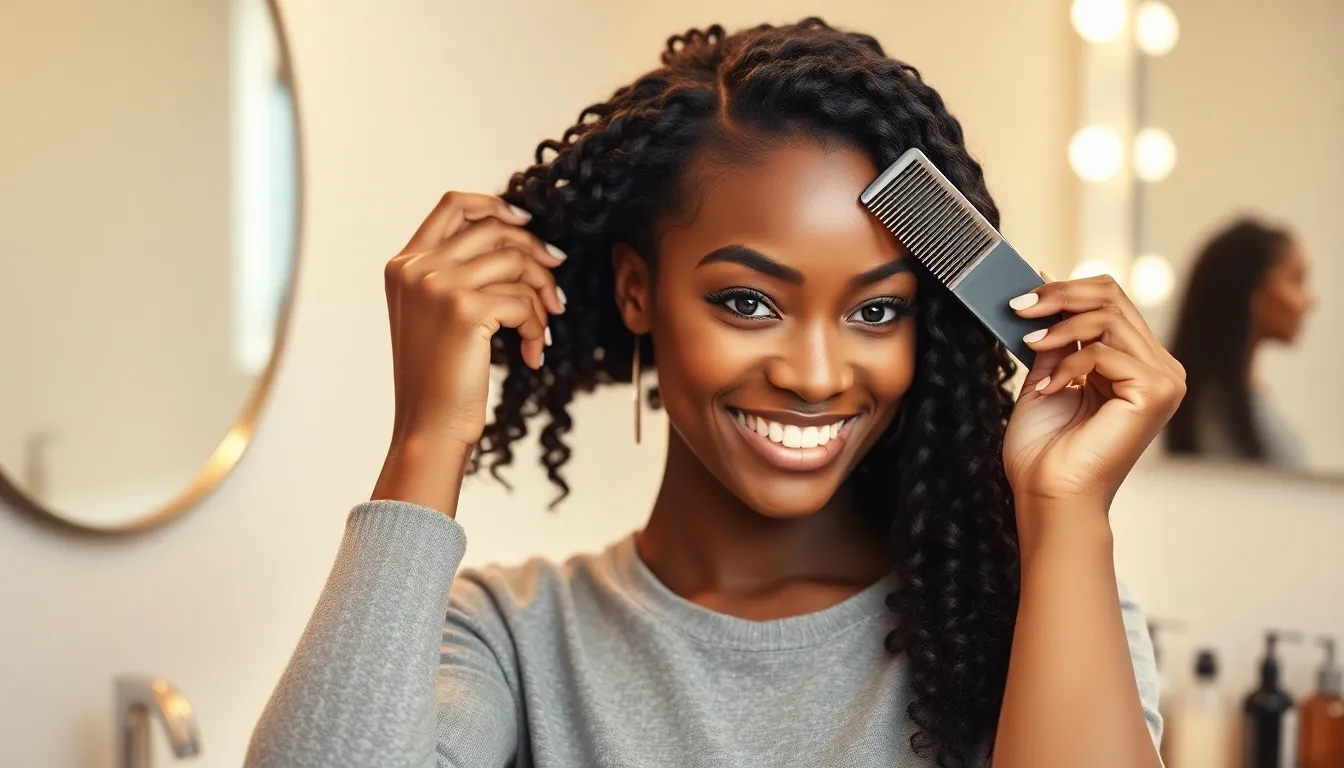
Proper maintenance extends the life of your clip in extensions while keeping them looking fresh and natural. We’ll walk you through essential care routines that protect your investment and maintain the health of both your extensions and natural hair.
Daily Maintenance Routines
Detangling becomes your most important daily habit when working with clip in extensions. Start from the bottom sections and work upward using a wide tooth comb or extension exact brush to prevent unnecessary breakage. Gentle strokes reduce stress on both the wefts and your natural hair underneath.
Moisturizing keeps your extensions soft and manageable throughout wear periods. Apply lightweight leave in conditioners or moisturizing sprays specifically formulated for textured hair to maintain flexibility and reduce brittleness. Focus the product on mid lengths and ends rather than the clip attachment areas.
Remove extensions before sleeping to prevent tangling and reduce tension on your scalp. Store them properly each night rather than leaving them clipped in, as this maintains their shape and prevents unnecessary wear on the clips themselves.
Washing and Conditioning Methods
Wash your clip ins approximately every 2 to 3 weeks or after 15 to 20 wear sessions depending on product buildup and styling frequency. This schedule prevents over washing while keeping extensions clean and fresh for optimal performance.
Detangle thoroughly before any washing routine to prevent matting during the cleansing process. Separate each weft carefully and work through any knots with your fingers or a wide tooth comb before introducing water.
Choose sulfate free shampoos and conditioners designed for extensions or natural textured hair to avoid harsh chemicals that strip moisture. These gentler formulations preserve the integrity of both human and synthetic extension fibers while maintaining softness.
Use lukewarm water instead of hot temperatures to wash extensions and preserve their texture and longevity. Hot water can damage extension fibers and cause premature wear, especially in synthetic options.
Air dry exclusively rather than using heat tools to maintain the natural movement and softness of your extensions. Gently squeeze excess water with a clean towel, then lay flat or hang the wefts to dry completely before storage.
Proper Storage Techniques
Store extensions in clean, dry locations away from direct sunlight to prevent color fading and fiber degradation. Choose storage areas with consistent temperature and low humidity to maintain extension quality over time.
Use satin or silk pouches for individual weft storage to prevent tangling and dust accumulation between wear sessions. These smooth fabrics reduce friction that can cause matting or breakage during storage periods.
Ensure complete drying before storage to prevent mildew and bacterial growth that can damage extensions and create unpleasant odors. Even slight dampness can lead to serious problems during extended storage periods.
Lay extensions flat on clean surfaces when not using protective pouches to maintain their natural shape and prevent clip distortion. This method works particularly well for longer wefts that might tangle when stored vertically.
Troubleshooting Common Issues
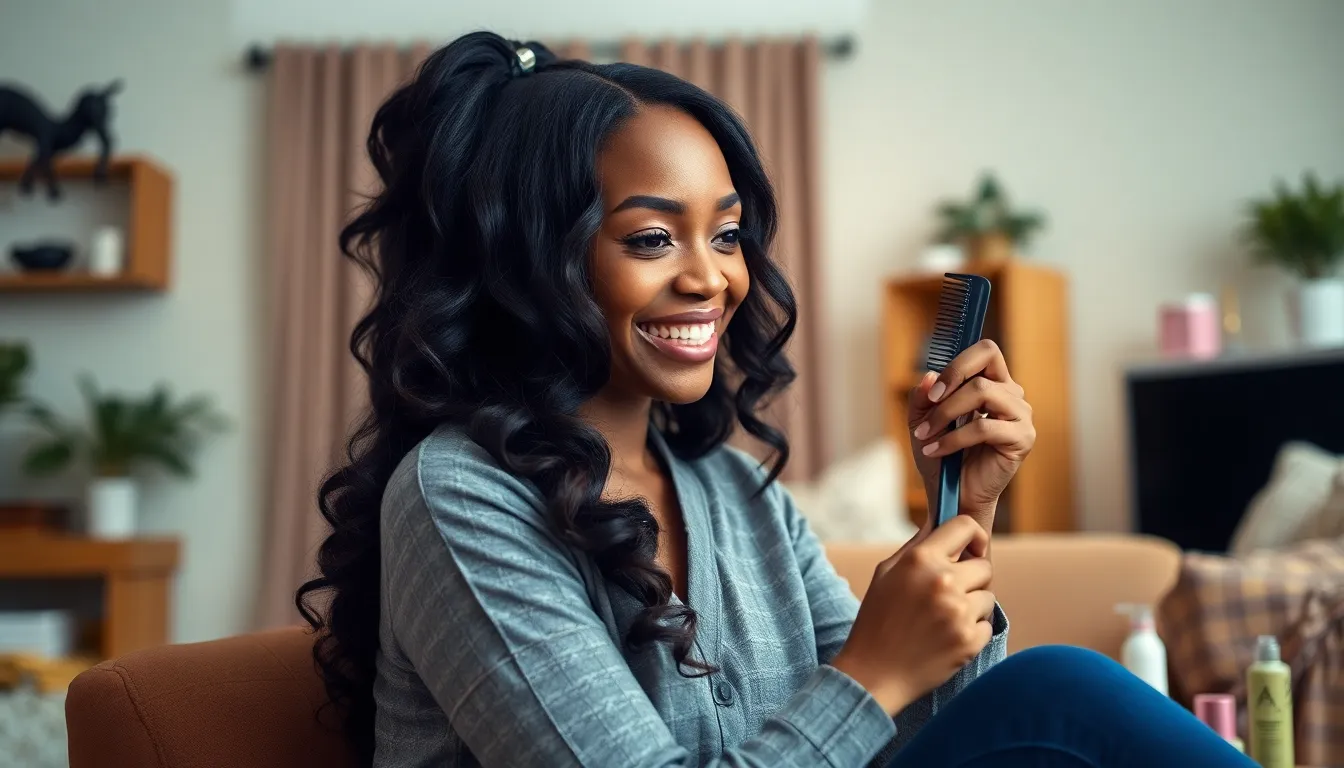
Even with careful selection and application, clip-in extensions can sometimes present challenges that need quick answers. We’ve identified the most common problems black women encounter and how to resolve them effectively.
Preventing Slippage and Tangling
Secure your clips properly by positioning them close to the natural hairline for maximum grip. We recommend teasing your natural hair slightly at the roots before clipping in extensions to create texture that helps hold the wefts in place.
Apply a light mousse or texturizing spray to your natural hair before installation to enhance grip without weighing down your hair. Products like leave-in conditioners with light hold work exceptionally well for maintaining natural hair texture while providing security.
Check clip tension regularly throughout the day to ensure they haven’t loosened. We suggest gently pressing down on each clip every few hours to maintain their secure attachment.
Sleep with a satin bonnet or pillowcase to reduce friction that causes both slippage and tangling overnight. Braiding your hair loosely before bed also helps prevent extensions from shifting while you sleep.
Avoid over-manipulating your hair throughout the day, as constant touching can loosen clips and create tangles in both natural hair and extensions.
Dealing with Matting Problems
Detangle extensions daily using a wide-tooth comb or detangling brush, starting from the ends and working your way up to the roots. We always recommend working in small sections to prevent breakage and minimize stress on the hair.
Use a quality detangling spray before combing to add slip and make the process easier on both your natural hair and extensions. Look for products specifically formulated for textured hair that won’t leave residue.
Separate matted sections gently by hand before using any tools, as forcing a comb through severe tangles can damage the extension fibers. We find that applying a small amount of leave-in conditioner to matted areas helps loosen knots.
Remove extensions immediately if matting becomes severe, as leaving them in can cause damage to your natural hair. Clean and detangle the extensions thoroughly before reinstalling them.
Wash extensions properly when matting occurs frequently, using sulfate-free shampoo and deep conditioning treatments to restore moisture and manageability.
Fixing Color Mismatches
Choose extensions in natural lighting when shopping to ensure accurate color matching with your natural hair. We’ve found that indoor lighting can be deceiving and lead to poor color choices.
Blend multiple shades if you discover your extensions don’t match perfectly, using 2-3 similar tones to create a more natural appearance. This technique works particularly well for adding dimension to your overall look.
Consult a professional colorist for important color corrections, as attempting to dye extensions at home can damage the hair fibers. Human hair extensions respond better to professional coloring techniques than synthetic options.
Use temporary color products like hair chalk or wash-out dyes to adjust minor color differences quickly. These products allow you to experiment with blending without permanent commitment.
Consider the lighting conditions where you’ll wear your extensions most often, as colors can appear different under various lighting situations throughout the day.
Top Brands and Products to Consider
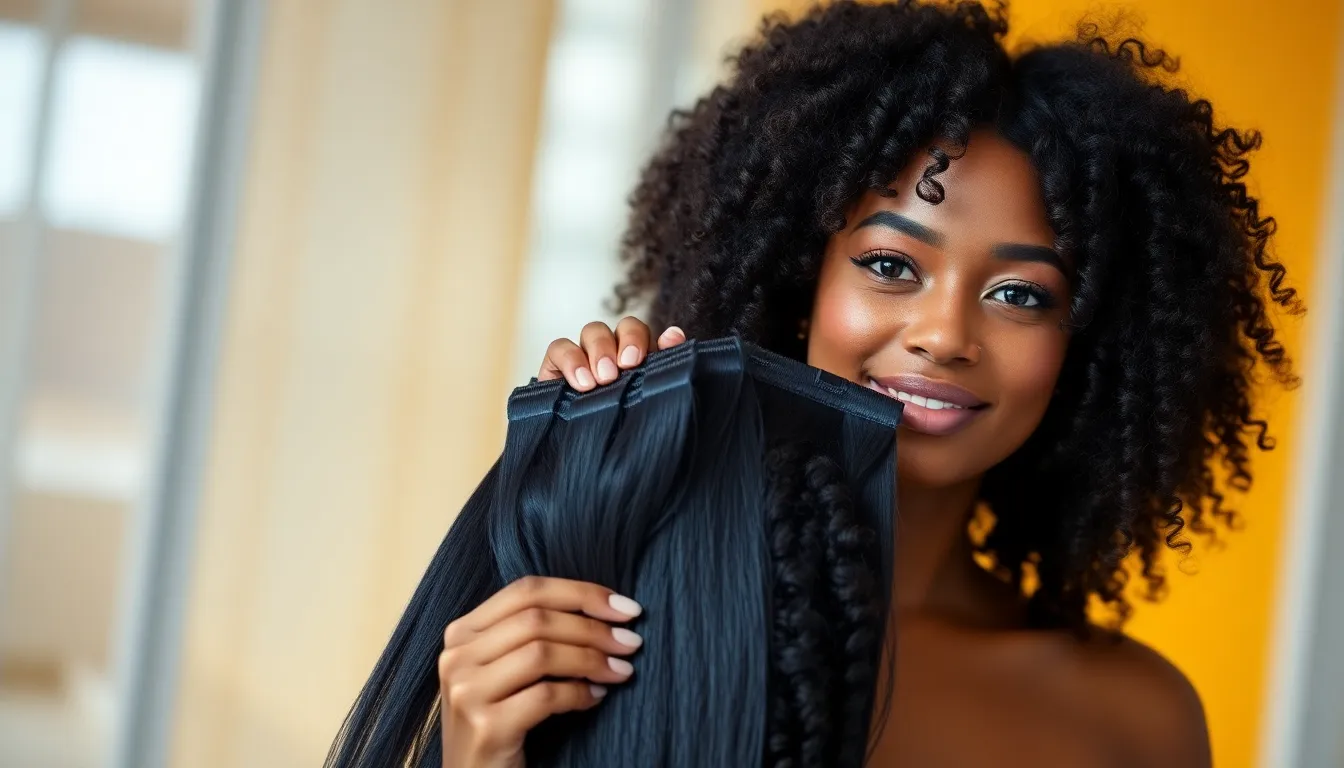
Several standout brands have earned recognition for their quality clip-in extensions designed specifically for Black hair textures. These companies understand the unique needs of kinky, coily, and curly hair patterns.
Premium Extension Brands
Heat Free Hair leads the premium market with their 100% virgin human hair clip-in extensions. Their product line features five distinct textures that perfectly match kinky, curly, and coily hair patterns. We appreciate their commitment to ethical sourcing and Black-owned business practices, which sets them apart in the industry.
Indique delivers exceptional quality with their 100% natural human hair clip-in extensions. Their extensions receive praise for versatility and easy styling capabilities. The brand’s high-end positioning reflects their dedication to superior hair quality and natural appearance.
Onyx Hair specializes in texture-exact collections that cater to natural Black hair. Their ONYC 3C-4A Coil and 3B Curl lines target exact curl patterns from tightly coiled (3C-4C) to curly (3B) textures. They also offer relaxed options like Light Yaki Relaxed Texture for women with chemically processed hair.
Budget-Friendly Options
Yummy Extensions provides accessible human hair wefts and clip-ins at various price points. Their range includes luxury options while maintaining affordability across different budget levels. The brand’s focus on supporting Black-owned businesses adds value beyond just pricing.
Onyx Hair and Indique occasionally offer value sets and seasonal sales that make their premium products more accessible. These periodic promotions provide affordable entry points into high-quality extensions. We recommend watching for these opportunities to access premium textures at reduced costs.
Specialty Products for Black Hair
Texture matching technology sets certain brands apart in serving Black hair needs. Heat Free Hair’s five-texture range addresses the full spectrum of natural Black hair patterns from loose curls to tight coils. ONYC 3C-4A Coil specifically targets women with tightly coiled hair textures.
Seamless blending features characterize the best specialty products for Black hair. These clip-ins mimic natural hair growth patterns and allow for easy removal and reapplication without detection. The technology focuses on creating invisible attachment points that work with natural hair movement.
Ethical sourcing practices distinguish Black-owned brands like Heat Free Hair and Yummy Extensions. These companies prioritize transparency in their manufacturing processes and sourcing methods. Their commitment to ethical practices resonates with consumers who value responsible business practices alongside quality products.
Conclusion
Clip-in hair extensions represent a game-changing solution for Black women seeking versatile styling options without permanent commitment. We’ve explored how these temporary additions can transform your look while protecting your natural hair from daily manipulation and styling damage.
The key to success lies in proper selection and application. By matching textures carefully and following our guidance on color coordination and volume calculation you’ll achieve seamless results that enhance your natural beauty. Remember that quality preparation and gentle handling techniques are essential for both extension longevity and hair health.
Whether you’re looking for special occasion glamour or everyday versatility clip-in extensions offer the perfect balance of convenience and style. With proper care and the right products from trusted brands you can enjoy beautiful transformations while maintaining the health and integrity of your natural hair.
Frequently Asked Questions
What are clip-in hair extensions and how do they work?
Clip-in hair extensions are temporary hair pieces that attach to your natural hair using small clips. They’re available in various textures that match Black hair patterns, from curly to coily. The clips are designed to grip securely without causing breakage and can be easily removed at the end of the day.
Why are clip-in extensions ideal for Black women’s natural hair?
The coily and kinky patterns of Black hair naturally help conceal attachment points, making clip-ins virtually undetectable. They protect natural hair from daily manipulation, allowing it to rest and grow while providing desired length and volume. This makes them perfect for achieving versatile styles without permanent commitment.
How do I choose the right texture for my clip-in extensions?
Match your extension texture to your natural hair’s curl pattern. Identify whether you have type 3 (curly) or type 4 (coily/kinky) hair. Kinky and coily extensions work best for type 4 hair as they replicate natural volume and movement, while curly options suit type 3 hair patterns.
What’s the best way to match the color of my extensions?
Examine your hair in natural sunlight for accurate color assessment. Use color charts and consider consulting a professional stylist. Take photos in natural light to help visualize the match. Consider your skin undertones when selecting colors, and don’t hesitate to blend multiple shades for a multi-dimensional effect.
How do I determine the right length for my clip-in extensions?
Consider your height, body proportions, and curl shrinkage when measuring for ideal length. Take photos in natural light to visualize different lengths. Remember that curly and coily hair appears shorter due to shrinkage, so you may need longer extensions than you initially think to achieve your desired look.
How should I prepare my natural hair before applying clip-in extensions?
Wash your hair with sulfate-free shampoo and deep condition for hydration. Use leave-in products to maintain moisture. Create protective styles like braids or flat twists to reduce tension and provide a smooth base. Avoid harsh chemicals or excessive heat before application, and ensure proper sectioning.
What’s the proper technique for applying clip-in extensions?
Start with strategic sectioning to create layers for seamless placement. Position wefts correctly and test their security during application. Blend extensions with natural hair by matching textures and creating subtle layers to camouflage attachment points. Style both natural hair and extensions together for a unified look.
How do I style clip-in extensions safely?
Always use heat protectant products and control temperatures to minimize damage. Limit heat exposure and use professional styling tools for optimal results. Consider protective styling opportunities that allow for low manipulation styles, promoting hair growth while reducing tension on your scalp.
What’s the best way to care for and maintain clip-in extensions?
Practice gentle daily detangling and moisturizing to keep extensions soft and manageable. Remove extensions before sleeping to prevent tangling. Wash with sulfate-free products and air dry to preserve integrity. Store in satin or silk pouches and ensure extensions are completely dry before storage.
How can I troubleshoot common clip-in extension problems?
Prevent slippage by securing clips close to the natural hairline and using texturizing products to enhance grip. Address matting with daily detangling and proper washing techniques. Fix color mismatches by examining shades in natural lighting and blending multiple tones for a more natural appearance.
What are some recommended brands for clip-in extensions for Black hair?
Premium brands like Heat Free Hair offer ethical sourcing and diverse textures, while Indique provides high-quality natural hair extensions. Budget-friendly options like Yummy Extensions offer accessible choices without compromising quality. Look for brands with texture matching technology and seamless blending features.
Are clip-in extensions cost-effective compared to other hair extension methods?
Yes, clip-in extensions are highly cost-effective as they’re reusable and don’t require professional installation. They’re also time-saving and promote hair health by avoiding glue or tight braiding. The flexibility to switch between natural and extended styles makes them a practical investment for variety.
